
Head Surgery Page Menu: 1 2 3 4 5 6 7 8 9 10 11 12 13 14 Next>>
Head Surgery During the Golden Age of Piracy, Page 4
Pre-Op
Several procedures took place before the surgeon decided which procedure he wanted to use to treat a head wound. The pre-operative procedures for the patient might include giving them alcohol and letting him blood. Procedural preparations involved shaving the patient's head, cleaning the wound, and searching for a fracture in the skull. Finding (or not finding) a fracture was essential to determining what procedures followed. Some of the more advanced pre-operative procedures (which actually involved minor surgery) included dilating (or opening) the wound and dressing the wound to help stop the bleeding.
Pre-Op: Giving the Patient Alcohol
Although there is a widespread belief today that alcohol was given to patients as a form of anesthesia during this time, the surgical procedure books from the golden age of piracy do not generally support this. A few authors do suggest giving small amounts of alcohol in advance of the two most dangerous operations - amputation and head injuries.

Artist: Jan van der Straet - Giving Medicine (1600)
The only author under study to suggest administering alcohol before head surgery is John Moyle. Moyle was a practical surgeon typically given to doing what worked best according to his experience. In his explanation of preparing for trepanning, he advises "first let the Man have a spoonful of your Cordial to cheer him."1 Cordials were liqueurs distilled from various plants. Note the small amount of alcohol that was suggested.
Moyle mentions the use of cordials in some of his case studies at sea although he doesn't identify which specific cordial water he used. (This may suggest that the medicinal properties were not important here.) In a case where a man had been hit with a crow bar in the skull, he says, "The Man had a Cordial given him, but Vomited it up again"2. In another where the sailor hit his head on a windlass Moyle explains how he gave the man a cordial, "but it stayed not with him; so he was had [taken] down out of the Air, between Decks, to be dressed."3
Given that vomiting was one of the symptoms of a fracture, particularly one that extended through both tables of the skull, it is not surprising that the sailors described were unable to keep the cordial down. It is likely that Moyle gave spoonsful of such a cordial in most of his head wound cases as prescribed in his book of surgical procedures but only mentioned them in case studies when they explained something else about the case, such as the vomiting symptom indicative of a serious skull fracture.
It is also important to reiterate that only one surgeon of all those under study suggests the use of alcohol before head surgery. It may not have been a common practice.
1 John Moyle, The Sea Chirurgeon, 1693, p. 108; 2 John Moyle, Memoirs: Of many Extraordinary Cures, 1708, p. 2; 3 Moyle, p. 12
Pre-Op: Bloodletting
Humoral treatments were used at a variety of times during the healing of a patient with a head wound. One of the four bodily humors is blood. At this time, surgeons believed that a wound site could generate corrupted humors, so bleeding was often prescribed in conjunction with wounds. The first occasion for intentionally bleeding the patient occurred before any operation had taken place. Combined with the idea that the moon could create an excess of bodily humors, bleeding would have made sense to period surgeons in cases where there was no wound or the wound had not bled very much because it would allow the excess blood to escape. (Excess blood was thought to become stagnant and then corrupt, infecting the body with "bad" humors.)
In one of his case studies, sea surgeon John Moyle explains how the patient 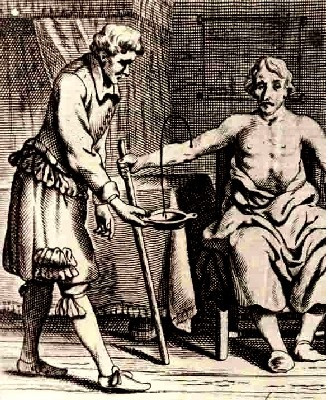
From Armamentium Chirugiae, by Johannes Scultetus (1693) "was had down [to the deck of the ship where the surgical theater was set up, probably the orlop deck] to be dres’d; and venæ Section [bleeding] was immediately celebrated to prevent the Blood’s Coagulating, and induce its more free Circulation, which gave [the patient] something of Relief"1.
Moyle is the only period author under study to specifically recommend bleeding before other surgical procedures had been performed on a patient. As he explained in another case study involving a sailor with a head wound, "I let him Blood immediately; for that is not to be neglected in all grand Contusions, whether external or Internal."2
In yet another case, he notes that a surgeon who had been treating a sailor with a head wound before Moyle had failed to "let the Man blood; which, in contused Wounds, ought not to be omitted, and much less in Fractures, (as here was one, although he [the other surgeon] was ignorant of it.)"3
In still another case, Moyle bled an unconscious seaman who was already bleeding. "The Man bled at Mouth and Ears, and had all signs of a concussed Brain; but Life being perceiv’d in him, he was let Blood instantly: which Operation may not be omitted in any-wise in these cases."4 This is unusual because many surgeons thought when a man was already bleeding it was unnecessary to bleed him more at that time.
Notice that Moyle doesn't go into detail about bloodletting, although it was likely performed using a vein in the man's arm, the most common site. Bleeding to relieve the humors was also performed using veins in the neck and even the temples on occasion, although the arm was the most common site used. If he had used non-arm locations, Moyle would likely have mentioned this.
Once again, pre-surgery bloodletting is only advised by Moyle, suggesting that this may not not have been widely performed on head wound cases.
1 John Moyle, Memoirs: Of many Extraordinary Cures, 1708, p. 2; 2 Moyle, p. 19; 3 Moyle, p. 23; 4 Moyle, p. 12
Pre-Op: Shaving the Head
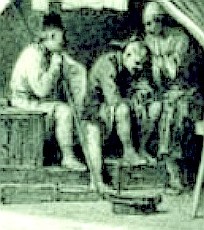
Artist: Auguste Raffet
Shaving the Skull, Barbier Tzigane (1839)
Shaving the head (or at least shaving part of it) was an integral part of most head surgeries. Finding skull fractures was usually difficult enough with the head shaved, let alone trying to find them with hair in the way. Hair was also a liability because it would have gotten tangled in the surgical tools used to operate on the head. Since shaving was a normal part of the ship's surgeon's job, he would have had the tools at hand.
Ambroise Paré says that "if the wound made in the musculous skin shall not be thought sufficient for ordering the fissure [in the skull], then must he [the surgeon] shave off the hair" in preparation for treatment.1 Military surgeon Richard Wiseman repeatedly mentions shaving a patient's hair before attempting to work on a head wound2 as does sea surgeon John Atkins.3
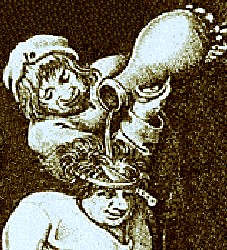
Artist: Peter Bruegel the Younger
Over-Humecting the Skull (1559)
Sea surgeon John Woodall explains to his readers, "The place therefore found where the fracture is, it then followeth that the haire must be first shaved away, or at least (which is not so good) cut close for a good distance about the greefe 4 fingers broad or more"4.
Woodall is the only surgeon under study to suggest partially shaving the head. When faced with a head wound previously treated by another surgeon, John Moyle said "'Tis true, he [the other surgeon] had shaved the Hair about the Wound, but not the whole Head, (which he ought to have done,)... [so] I had the Head shaved all over; it was vastly Turgid [swollen], and the Wound looked ill."5
The process itself is fairly straightforward. Moyle notes that a man's head would be "shav’d with a Capital Razor, when the Hair had been first moistned toward the Roots with Oyl-Olive."6 The description of the razor as being a 'capital' razor is interesting. When detailing the instruments a surgeon must have, Moyle lists "dismembering Saw with two blades, Head Saw, dismembering Knife, Catlings [knives with sharpened blades on each side for amputation], Incision Knife, Capital Instruments, Traphine with two heads" and several other instruments.7 He doesn't describe the 'Capital Instruments' in any further detail, although given that they are listed among the amputation and trepanning instruments, it seems likely that they were reserved for use in these two capital operations. Moyle elsewhere calls dampening the hair with oil 'humecting'8 and specifically notes that the Hair was "moistned with Oyl on the Epidermis"9.
1 Ambroise Paré, The Workes of that Famous Chirurgion Ambrose Parey, 1649, p.265; 2 For examples, see Richard Wiseman, Of Wounds, Severall Chirurgicall Treatises, 1676, p. 393 & 398; 4 John Woodall, the surgions mate, 1617, p. 4; 5 John Moyle, Memoirs: Of many Extraordinary Cures, 1708, p. 22-3; 7 John Moyle, The Sea Chirurgeon, 1693, p. 22; 8 Moyle, Memoirs, p. 12; 9 Moyle, Memoirs, p. 18
Pre-Op: Cleaning the Wound
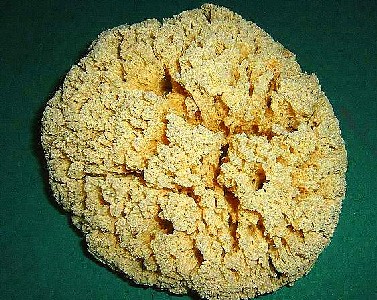
Photo: Wiki User Peng - A Natural Sponge Cleaning an open head wound was an important step to facilitate healing as well as to allow the surgeon to see how severe the damage was. Military surgeon Richard Wiseman discusses this in a case study of a soldier with 'many wounds on his head' including sword wounds and a skull depressed by 'Sword, Musket-stock, &c.': "I seeing the Hairy scalp of one side of his Head hanging down his Neck, went to him, ...calling my Friend Will. Clarke to me with a Spunge to cleanse the Wound"1.
In another case, where a man had been shot in the right side of his head, Wiseman explains how they "laid the Cranium bare by a circular Incision, and permitted it to bleed awhile; then cleansed it with a Sponge prest out of Vinegar, and fill’d it up with dry Lint" which they left in for 'an hour or two' to stop the bleeding.2
While most of the other surgeons under study don't mention how they cleansed a wound to get a better look at, it is almost certain they would have done so.
1 Richard Wiseman, Of Wounds, Severall Chirurgicall Treatises, 1676, p. 399; 2 Wiseman, p. 402
Pre-Op: Searching for a Fracture
Probably the most significant pre-operative procedure for a head wound was trying to find a fracture in the skull. Decisions about the type of operation to be performed often depended on the location and type of fracture. Searching for a fracture was first attempted on the newly shaved skull of a patient.
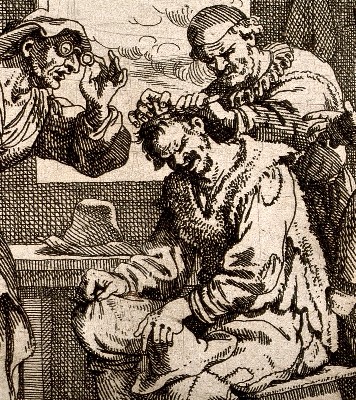
Surgeon Examining the Skull, From the Wellcome Collection French surgeon Ambroise Paré told his readers that they would
know when the scull is fractured, by the judgement of your externall senses, as if by feeling it with your finger you finde it elevated or depressed beyond the naturall limits, if by striking it with the end of a probe, when the Pericranium or nervous filme that investeth the scull is cut crosse wise [by a wound]; and so divided there from it, yield a base and unperfect sound like unto a pot sheard [potsherd - a fragment of pottery] that is broken, or rather like unto an earthen pitcher that hath a cleft, or rent therein.1
Paré lists another interesting method for detecting a fracture in a wounded skull. He counsels,
if the hairs stand upon one end in the wound, you may know the bone is broke, because the hair which yeelds to the violence of the blow, cannot be so cut, the bone which resists the stroak being not violated... wherefore we may by the sight of this one thing, before any inspection of the wound it self, suspect by a probable conjecture that the skull is broken, and perswade the beholders or standers by so much.2
Paré is actually the only surgeon under study to mention searching the uncut cranium for a fracture, although it seems likely that other surgeons would have used similar methods if they were not in a hurry.
However, the majority of the discussions about finding the fracture in a damaged skull centered around cutting the scalp open so that it could be better discovered. If the patient was exhibiting symptoms of a serious skull fracture and surgeon couldn't find evidence of that fracture through the non-invasive methods, he would likely cut open the scalp for a better view.
1 Ambroise Paré, The Workes of that Famous Chirurgion Ambrose Parey, 1649, p.204; 2 Paré, p. 265;
